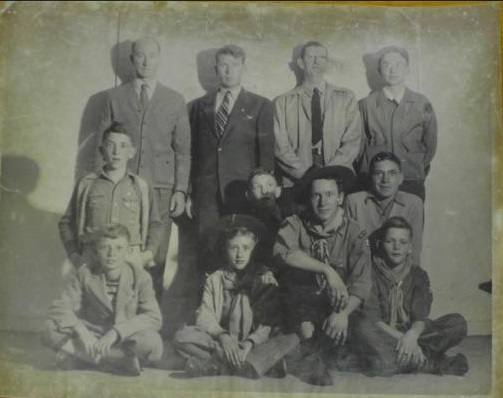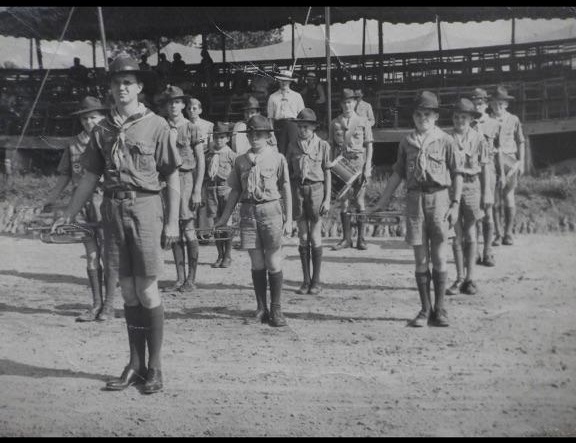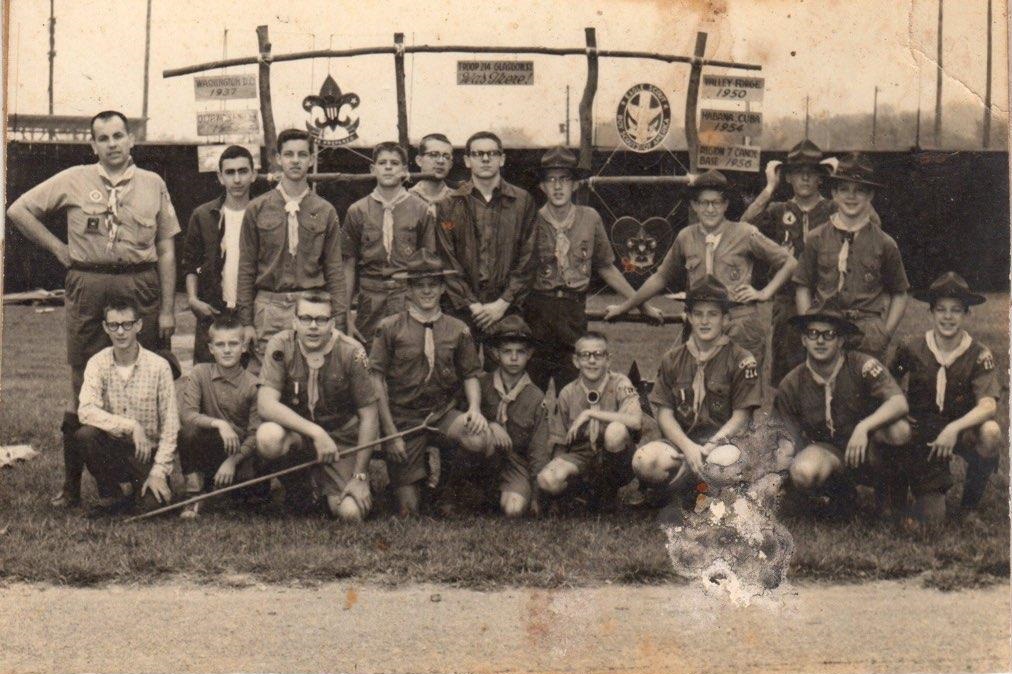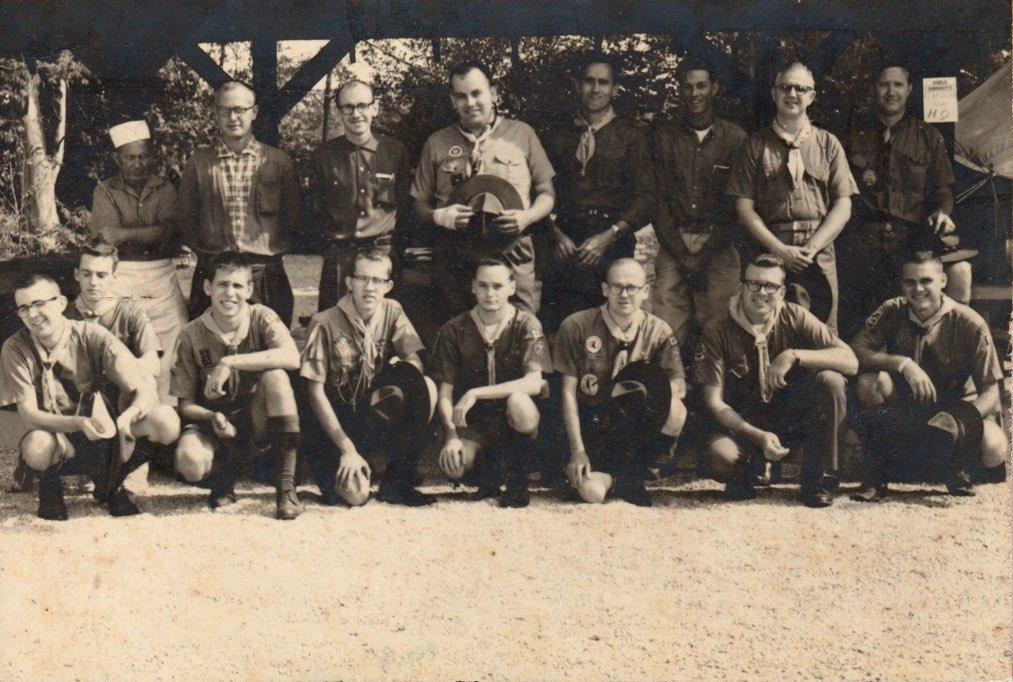Foundation of Scouting in Glasgow, KY. and History of Camp Rotary
Scouting comes to Glasgow
In 1912, two years after the Boy Scouts of America were chartered, a troop was started in Glasgow, KY. Mr. William Henry Jones attended a scouting rally held in Louisville, KY and was captivated by the vision of scouting conveyed to him Mr. Dan Beard. He returned to Glasgow and formed Troop Number 1 with the Reverend Harvey Baker Smith, a minister at the First Christian church, recorded as Glasgow’s 1st Scout Master. The Troop 1 designation remained until 1930 when troops began to be numbered by district, defining Glasgow as Troop number 214.
Early camping events were held over a hundred miles away at Covered Bridge in Prospect, KY. before all roads to Louisville were paved. The distance involved and challenging travel conditions created an adventure in just getting to the campgrounds. Desiring a local site to conduct scouting activities for youth of the area, the Rotary Club began collecting money in the latter part of the 1920’s. Once a reasonable amount of funds were collected, the board trustee’s at the time, Dr. D.B. Hodges, Dr. Fidella Edwards and Mr. Jack Allen Bryant entrusted Scout Master Mr. Cal Rogers, a man said to have travelled every hill and gully in the area, with the duty to find such a site.
A home for local Scouts
In 1931, Mr. Rogers encountered freed slaves Mr. George Page and his wife Fanny, who wished to try their fortunes elsewhere. They were selling 30.5 acres in Temple Hill, along with their modest home for $650.00. The Page home was located at what is today referred to as little Gilwell field, named after the 1st location dedicated to exclusive scouting use, Gilwell Park. The English namesake was purchased in 1919 and is in Epping Forest near Chingford, London. Our original scout property was described as a timbered ridgeline, having an abundance of cherry and persimmon tree’s, flowing west from the home site to end in 200 feet of frontage on Skaggs Creek. Numerous daffodil flowers planted by the Page’s continue to bloom and spread year after year around Gilwell field.
After purchasing the property, Mr. Cal Rogers and fellow Scout Master Mr. Addis Britt would work on the land, now named Camp Rotary, throughout the day to clear a road back from Woods Store Etoile and stayed overnight in the former Page home. Weekends were given to scouting activities. While the 1st troops worked tirelessly on cutting the road and further making the land suitable for scouting activities, time was always set aside for fun and learning the scouting way.

1930's
In 1933, Mr. Charlie Peden donated a log cabin from the nearby Thompson-Peden farm. Volunteers from the local Coca-Cola plant, located on Front Street in Glasgow, relocated the structure to occupy the location now known as the Upper Cabin. The cornerstone for the new foundation was laid by Mr. Cal Rogers, Joe Lewis Goodman and J.D. Deweese. The relocation, repair and improvement of the Upper Cabin is recorded as the 1st build project for the camp. The Rotary Club took up a collection of roofing shingles resulting in a “roof of many colors”.
The "New Deal" helps the Camp
In the latter part of the 1930’s and early 1940’s, the camp was the recipient of Work Progress Administration efforts under President Roosevelt’s “New Deal” program. Nine small cinderblock cabins and a latrine were built near the Upper Cabin. A porch was added to the west end of the Upper Cabin and a concrete floor was laid inside. A small portion of the cabin floor was left exposed to dirt to allow fires to be built inside. An inverted funnel like apparatus was installed with the intent to allow smoke and fumes to escape. Dr. Lewis Dickinson is noted as humorously recalling it as “efficient at letting the heat out and keeping the smoke in”.
From its inception in the early 30’s until 1948, Camp Rotary grounds were used exclusively by local scout groups. Scout members recorded in the initial troop are Dr. Lewis Dickinson, Dr. Bryant, Mr. Boots Vance Esq., Mr. Joe Lewis, J.D. Deweese and Mr. John Lewis Rogers. Some members travelled to represent Glasgow’s troop at the nation’s 1st Jamboree held in Washington, D.C. in 1937.
1940's
In 1948, Camp Councils were held at Camp Rotary for the 1st time.

1950's
In 1950, then Scout Master Mr. Jimmy Simmons attended the National Jamboree at Valley Forge, PA. and encountered a group of Canadian “Rovers” who greatly impressed him. He learned that “Rovers” were an organization that was structured to reinforce and continue the development of scouting virtues for individuals that had graduated from youth oriented scout programs. Mr. Simmons saw great virtue in this program and chartered Rover Crew 1 of Glasgow, KY. in 1951. The Glasgow Crew continually increased in numbers and influence throughout his lifetime and helped foster the formation of Rover Crews in several other cities.


Patrol style camping is recorded as being practiced at Camp Rotary in 1951, through which several groups would operate independently to foster leadership skills and promote teamwork to achieve common goals. In 1953, a summer camp was held using tents both in Brownsea and little Gilwell fields. Camp Rotary’s Brownsea field was named after the location of Mr. Baden-Powell’s 1st scouting event, at England’s Brownsea Island. Little remains to mark the location of Camp Rotary’s Brownsea field other than the remnants of an old fire circle. It was located east of Boy Scout Camp Road south and east of the old hand operated water pump just off the road. In the winter of 1953, the 1st Rover Crew “Wee-Moot” was held at Camp Rotary. This event eventually grew into a bi-annual event that was attended by people around the world. In the mid to latter part of the 50's, a cabin was erected a few yards off of the 200 foot frontage on Skaggs Creek near the southwest camp border in an area known as the Lower Cabin.
1960's
Near the mid 1960’s, fire claimed the Lower Cabin. During October of 1966, Mr. and Mrs. Whitney Starr donated a cabin formerly owned by Mr. Wood Hall from the Wood Hall Ranch with the intentions to replace it. The area where the cabin was originally located was submerged as part of the construction effort to create Barren River Lake. According to accounts, the cabin logs were taken to a location near the Glasgow Water Tower but unfortunately, never erected.
1970's
Another Lower Cabin with two rooms and full front porch was constructed utilizing the fireplace and chimney from a previous Lower Cabin.
1980's
Creation of the Rotary Scout Foundation
In the early 1980’s The Rotary Scout Foundation was formed to prevent a decline of Camp Rotary’s property and structures. The 1st project undertaken was the renovation of the Lower Cabin area. The state of the Lower Cabin had declined to the point that the roof was falling in and numerous cows from adjacent farmer Mr. Noel Elmore had the misfortune to routinely fall through the floor.
The 1980’s were a watershed decade for the camp. In the mid 1980’s, a shower house was built at the Upper Cabin area featuring a concrete floor, two shower stalls, two toilets and an open-air sink. It even had hot water!. Judge Benny Dickinson has been noted to say that in the past, wash up at the camp involved a bar of Ivory soap (because it floats) and Skaggs Creek. Just add scouts and agitate briskly.Also added or improved upon during this time was a speaking ring or open air auditorium with a crude fire ring and benches arrayed in an arc. The ring is located to the west of the last cinder block scout cabin. A weathered rock and concrete wall forms the western end of the area attesting to possible use for similar other purposes during an earlier time.
Camp Rotary Grows-Creation of the Rotary Scout Reservation
In 1987, the Wilkerson family, who had been farming on land deeded to them in the early 1800’s, decided to sell 146 acres of property adjacent to Camp Rotary. In November of 1987, during an auction against other bidder’s intent on logging woods on the property, the Rotary Scout Foundation successfully bid due to a generous donation from one of the original scout troop members, Mr. Boots Vance. The existing scout property controlled by the Rotary Scout Foundation was joined to the new land to create the Rotary Scout Reservation, with its lands continuing to be known as Camp Rotary.
Also in 1987, an earthen dam was built by the Larry Glass construction company across a small creek near the old tobacco barn creating a 3.1 acre lake. Subsequent additions to the lake area added a bankside swimming dock and a 3 sided shelter with sleeping loft. For years, a floating 10’x7’ platform constructed by planking nailed over top of barrels could be found, usually by the lake shelter, unless it broke its tether. In 2014, it’s roaming privileges were revoked and it was permanently attached to a small dock that was built near the 3-sided lakeside shelter.In the latter part of the 1980’s, a shelter was erected in the southeast corner of Gilwell Field. This 15’x25’ open air structure features a concrete pad whereupon several picnic tables rest. A nearby massive rock cooking pit and water pipe makes this location ideal for cookouts. Latrines were erected off the field on both the southeast and southwest sides.
Also during this time, local Amish tradesmen were employed to deconstruct and relocate a grain silo near the old tobacco barn for their own use and to stabilize the condition of the old tobacco barn.
1990's
In the early 1990’s excessive flooding along Skaggs Creek prompted a land swap with our farming neighbor, Mr. Elmore to our mutual benefit. Camp Rotary exchanged a barn and adjacent flood free land near the old tobacco barn by the lake for land he owned along Skaggs Creek. The original 200 feet of creek front grew to encompasses better than 3000 feet. Shortly after the land swap, 1200 walnut trees were planted in the new area and named Walnut Bottoms in honor of a favored camping retreat in South Carolina. It’s well worth the trek to the southeast area of the Camp to view what is becoming a majestic grove near the creek.
2000's
Several bird houses were erected around the perimeter of the lake and can be found along a 2.2 mile nature trail that was added in 2004 which traverses many beautiful views and points of interest through the camp.
During 2004 and 2005, an arrangement was made with Mr. Hank Jackson to cut the hay off the fields two time a year. Additionally, bush hogging was conducted as needed to clear areas required for scouting activities.
The Upper Cabin was a stalwart survivor remaining in continual use until 2005 when its condition had deteriorated to the point where the sagging roof made passage through the cabin difficult and safety questionable. Originally slated for refurbishment, project manager Joe Austin deemed a complete teardown and rebuild was required. Several logs and pieces of the original cabin were salvaged to preserve a touchstone to the past. Work progressed steadily over the next two years with assistance from trustee labor, The Royal Rangers, former scouts and the community at large. The 2006 version of the Upper Cabin retains much of its original character while incorporating many wonderful additions such as a sleeping loft, massive porch located fireplace, standing seam roof and closeable porch to kitchen serving hatch.
In 2005, The Royal Rangers undertook re-beaming and re-roofing the shower house with standing seam roofing. They also improved the shower house by adding a 3 sink countertop and enclosing the open-air sink. Also, In August of 2005, the southwest latrine for Gilwell field was completely refurbished through the service of an Eagle Scout project performed by Christopher Lee McCloud of Troop 231.
During their involvement with the camp, The Royal Rangers continually repaired and improved upon the condition of the tobacco barn including the addition of an outdoor stage.
In 2006, the speaking ring or open-air auditorium was improved upon through an Eagle Scout service project performed by Andrew Moloko of Troop 747 which added a cedar podium and bench as well as forming an improved rock and concrete fire ring. Fallen timber was used to build a perimeter around the area but has since returned to nature.
Also in 2006, a small foot bridge was constructed on the nature trail near the eastern most point of the lake crossing over its the feeder creek.
Since 2006, Mr. Joe and Brad Bertram have cut the hay off the fields twice a year and bush hogged as needed. Additionally, anytime or way that we have asked for their assistance they have gone above and beyond. They are truly an invaluable contributor to the camp.
In 2007, a firing range was constructed by The Royal Rangers in the south west quadrant of the field between the lake and Upper Cabin area. Although the charter of the Rotary Scout Reservation specifically prohibits any firearms from being present on Camp Property, a contractual oversight permitted its construction. Adopting a “when life gives you lemons” perspective, the board has recently authorized use of the range for Scouts to earn their Rifle Shooting Merit Badge. An NRA authorized Range Master must be present during all firearm activities and the firearm ban remains in effect for all other areas of the camp. The range is well constructed with sheltered shooting positions and a reinforced stop wall. However, this area is not used often and cleanup and repair may be needed before further use.
In 2009, another fire at the lower cabin location prompted yet another rebuild. The massive rock fireplace from the previous cabin was all that was retained for what we hope is, “a long lasting successor”. The new cabin is on a smaller footprint having only one room but a sleeping loft was incorporated to increase usable floor space and retains the full porch on the creek side. Trustee labor, former scouts, The Royal Rangers and the community at large contributed to the completion of this project. The 1st post construction addition to the lower cabin was the installation a porch swing by Mr. Brian Shields. His fond memories of time spent there required its quick return.
2010's
In October of 2015, Mr. Joe Austin started work on a cabin which will be located in the southwest area of Gilwell field. What was originally a “dog trot” cabin (2 cabins with one overhead roof and joined by an open area on the ground floor) donated by Mr. Doug Frasier is being rebuilt using original logs but will incorporate many modern building materials and methods. The cabin donated originally stood in Buffalo, Ky. As with other builds, trustee labor, former scout and community support is helping to see this project through.
In 2016, 428 trees, many of them old growth, were lost due the installation of a power line across camp property. Camp Rotary invested substantially for stump grinding and ground prep to plant native KY grasses. Since these efforts were mutually beneficial for maintenance of the right of way, the contractor, Eastern KY Power, shared some cost for this effort. Although too early to determine results of long term sustainability, a field of beautiful native flowering forbs bloomed the in the spring of 2017.
In 2017, The Royal Rangers added a small foot bridge crossing over a creek behind the tobacco barn leading to the area of the firing range.
Tribute
As of 2020, 89 years have passed since the inception of Camp Rotary. The Rotary Scout Reservation continues traditions established by Camp founders. Through its humble beginnings, we learn that the benevolent acts of a few, can bring great opportunity to many. Far too few are mentioned in this narrative simply because the number of persons who have contributed their time, possessions or monetary gifts exceed the writer’s ability to accord them all the gracious thanks due.
History of Camp Rotary as provided by Judge Benny Dickinson. Amended, appended and updated using a variety of sources including former local scouts, archives from The Glasgow Daily Times, WCLU Radio and open internet sources related to scout history.
Scouting prior to the formation of Glasgow’s 1st Troop.
Today’s scouting programs are rooted in efforts of a former British war hero to guide the development of high moral values within youth through nature oriented learning activities. After retiring from military service, Mr. Baden-Powell, learned that youths in Britain were using a military manual he had written, “Aids to Scouting”, to conduct their own training exercises. To assist with their efforts, he arranged and held a two-week camp off the coast of Britain on the island of Brownsea beginning August 1st, 1907. This is considered the 1st organized scout gathering. In 1908, he published what is considered the 1st scout handbook, “Scouting for Boys”, a best seller, that led to the creation of troops not only in Britain but overseas in Canada and the United States as well.
At the time of its initial founding on February 8th, 1910, 50 or more unorganized troops were operating in the United States. The official Boy Scouts of America charter was incorporated by Chicago Newspaper publisher Mr. William D. Boyce following a meeting with Mr. Baden-Powell. Mr. Boyce sought the meeting after being deeply impressed by a chance encounter in a dense London fog with a scouting youth. Mr. Boyce, having become lost, was led to his destination by the boy who refused a tip for his assistance stating that “Scouts do not accept tips for courtesies or good turns”. Mr. Boyce wished to promote similar values in America’s youth and undertook the steps to officially found the Boy Scouts of America.
Mr. Dan Beard, author of “The American Boy’s Handy Book” and renown illustrator, along with Mr. Ernest Thompson Seton, author and illustrator of numerous nature and native Indian books, assumed top positions within the newly formed American scout organization. Both gentlemen previously formed and led youth groups with similar nature inspired goals several years before the Boy Scouts were organized. Mr. James E. West, a successful attorney who overcame much personal adversity, drove administrative and logistical efforts which built the nascent organization into the largest youth organization in the world.